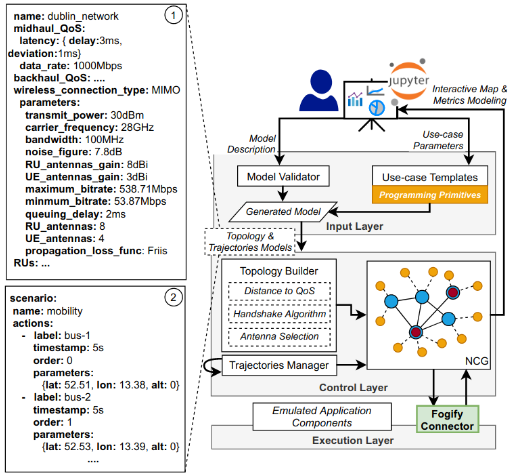5G-Slicer Extension
Experimentation with 5G-enabled services over network slices is extremely challenging as it requires the deployment and coordination of numerous physical devices, including edge and cloud resources. To alleviate the difficulties in setting up real-world 5G testbeds, we introduce 5G-Slicer extension of the Fogify framework. 5G-Slicer facilitates the definition of mobile network slices through modeling abstractions for radio units, mobile nodes, trajectories, etc., while also offering realistic network QoS by dynamically altering -at runtime- signal strength. Moreover, 5G-Slicer provides an already realized scenario for a city-scale deployment that smart-city researchers can simply configure through a "ready-to-use" template, leaving 5G-Slicer responsible for translating it into an emulated environment.
Features
5G Slicing Modeling
5G-Slicer offers high-level modeling abstractions for 5G radio units, backhaul & midhaul QoS, user equipment, edge & cloud compute resources, VNFs, etc.
Positioning & Mobility
The system provides positioning provisions and can alter at runtime the entities' locations controlling in such a way the link quality, such as network latency, bandwidth, error rate, etc.
ITS Use case template
5G-Slicer provides a "ready-to-use" template for a city-scale transportation sector that users are able to introduce their services
Monitoring Capabilities
Slicing plug-in introduced new monitoring capabilities for packet-level monitoring and analytics to the emulation suite
5G-Slicer Overview
A typical deployment starts by either describing the application services and network fabric via the 5G-Slicer model specification or by parameterizing a “ready-to-use” testbed template. The model specification can denote a wide range of network slice parameters, including the position of compute nodes and RUs, network links and their QoS, mobile node traces, communication protocols and VNFs applicable on nodes. On the contrary, parametrizable use-case templates automatically produce 5G deployments for IoT applications. The output of each template is a programming view equivalent to a validated deployment description. The topology and trajectories are propagated to the control layer.
Then, the system extracts from the description the network slice specification and any signal degradation models defined during the modeling process. With these, it produces an in-memory Network Conceptual Graph (NCG), which contains the aforementioned information and will be used by the system for the runtime state propagation during the experimentation. The graph nodes represent network and compute devices annotated with information about their capabilities and deployed services, while edges denote the links between the nodes. The weight of each edge is determined by network QoS, incl. data rate, network delay, packet and error rate. Then 5G-Slicer translates the NCG to an emulated environment by utilizing the Fogify Emulator Connector.

Publications
For more details about 5G-Slicer and our scientific contributions, you can read the papers of 5G-Slicer and a published Demo. If you would like to use 5G-Slicer for your research, you should include at least on of the following BibTeX entries.
5G-Slicer’s paper BibTeX citation:
@INPROCEEDINGS{Symeonides2022,
author = {Symeonides, Moysis and Trihinas, Demetris and Pallis, George and Dikaiakos, Marios D. and Psomas, Constantinos and Krikidis, Ioannis},
title = {5G-Slicer: An emulator for mobile IoT applications deployed over 5G network slices},
booktitle = {Proceedings of the 7th ACM/IEEE Conference on Internet of Things Design and Implementation},
year = {2022}
series = {IoTDI ’22}
}
5G-Slicer’s demo BibTeX citation:
@inproceedings{Symeonides2020,
author = {Symeonides, Moysis and Trihinas, Demetris and Pallis, George and Dikaiakos, Marios D.},
title = {Demo: Emulating 5G-Ready Mobile IoT Services},
booktitle = {Proceedings of the 7th ACM/IEEE Conference on Internet of Things Design and Implementation},
year = {2022}
series = {IoTDI ’22}
}
Acknowledgements
This work is partially supported by the EU Commission through RAINBOW 871403 (ICT-15-2019-2020) project and by the Cyprus Research and Innovation Foundation through COMPLEMENTARY/0916/0916/0171 and INFRASTRUCTURES/1216/0017 (IRIDA) projects. The authors wish to thank Dr. Christos Tranoris and prof. Spyros Denazis of the U. of Patras for providing measurements from the “Patras 5G” testbed, which was supported by the 5GVINNI H2020 (EU grant agreement No. 815279)